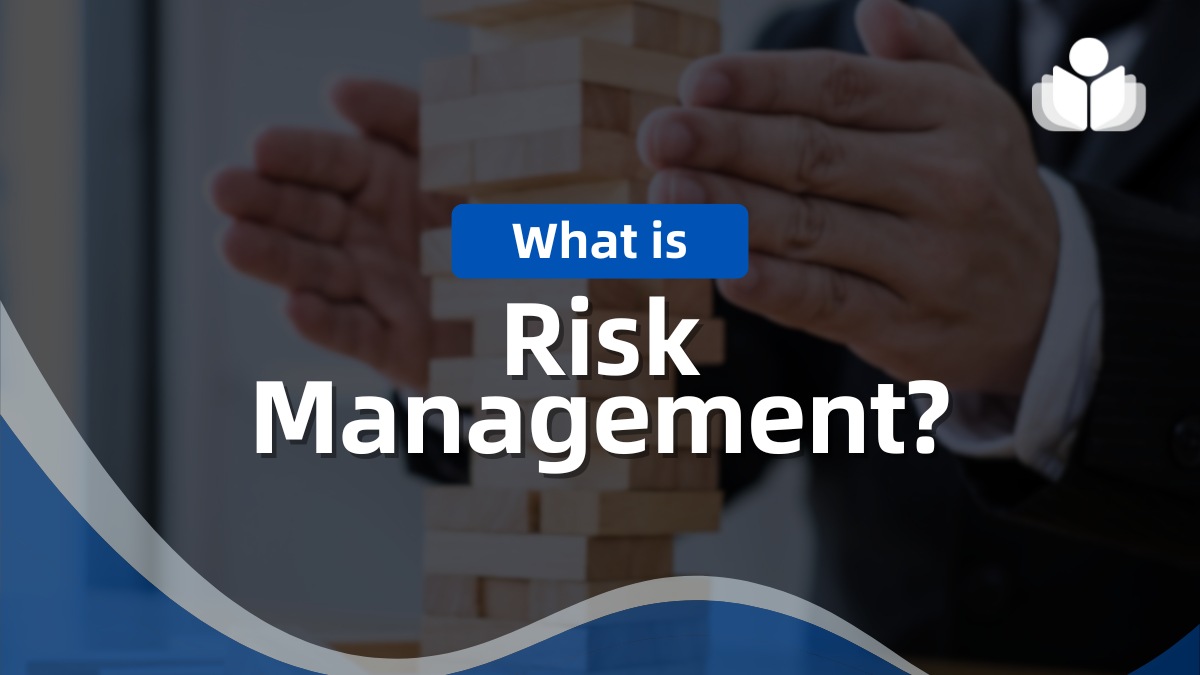Risk management is the practice of identifying, analyzing, and dealing with uncertainties that may impact a project, business, or decision-making process. At its core, it’s about recognizing potential risks before they become more significant problems and finding ways to prevent or reduce their impact. Risk management ensures you stay ready for the unexpected.
Why does risk management matter? In business and daily life, risks constantly pop up without warning. It’s impossible to know precisely what challenges lie ahead, but having a solid plan in place helps you make smarter decisions.
Whether protecting valuable assets, ensuring safety, or avoiding crises, risk management ensures the best chance of success. For instance, a business can avoid financial disaster by foreseeing and addressing potential market shifts.
The scope of risk management stretches across nearly every industry. The applications are endless, from financial institutions needing to guard against economic downturns to healthcare providers aiming to safeguard patient safety.
No matter the field, risk management plays a vital role in guiding organizations to minimize dangers while maximizing opportunities. The more you prepare, the better your outcomes will be, whatever sector you operate in.
Types of Risks
When discussing risks in business, companies face several categories, each carrying different threats. Let’s dive into the main risks businesses must consider and how they might affect operations.
Business Risks
Business risks directly influence how a company runs or how profitable it is. These can be split into three key areas: strategic, operational, and reputational risks. Strategic risks come from making big decisions about the company’s direction, like expanding into new markets. If a decision doesn’t go as planned, it can cause serious setbacks.
Operational risks are tied to the day-to-day activities of the business. For instance, if a factory’s machinery breaks down, it could disrupt production and hurt profits. Reputational risks involve any event that could damage a company’s image. Adverse publicity or a scandal can lead to customers losing trust, resulting in long-term damage.
Financial Risks
Financial risks revolve around anything that affects a company’s cash flow or financial health. Market volatility, liquidity problems, or changes in interest rates can all hit a company hard. For example, when stock markets drop suddenly, businesses could lose money if unprepared.
Companies often use strategies like hedging, using financial contracts to lock in prices or rates, to shield themselves from potential blows. Hedging helps ensure businesses can maintain stability even when markets are unpredictable.
Compliance Risks
Compliance risks arise when companies fail to meet legal or regulatory obligations. For example, failing to comply with environmental laws could cause heavy fines or penalties. This can occur in industries like manufacturing, where pollution controls must be carefully followed.
Having a solid corporate governance structure and staying updated with changing laws helps minimize these risks.
Cybersecurity Risks
In today’s digital world, cybersecurity risks have become a major concern. Threats like hacking, data breaches, and online espionage are becoming more common, and businesses must be prepared.
A data breach can expose sensitive customer information, which could lead to legal action or loss of trust. Strong cybersecurity measures, like firewalls and encryption, are essential for mitigating these risks.
Personal/Physical Risks
Lastly, risks affect not only businesses but also individuals. Personal or physical risks could include work-related accidents, injuries, or health-related issues. This connects with risk management on a more personal level, reminding us that safety and well-being are just as crucial to manage as business operations.
Insurance or workplace safety programs can help reduce the effects of these risks. Managing risks in all these areas keeps businesses and individuals ready to handle whatever might come their way.
The Risk Management Process
Risk management is an ongoing process that helps businesses and individuals anticipate, assess, and address potential challenges. The following steps provide a clear path for managing risks effectively:
Step 1: Risk Identification
The first step is identifying possible risks. This involves thinking ahead about what could go wrong in a project, business, or decision-making process. Businesses can use a variety of methods to identify risks. Brainstorming sessions are often a starting point for teams to discuss all potential risks.
Checklists can also be helpful, offering a way to track common risks relevant to a particular industry or activity. For more complex environments, businesses might turn to specialized risk management software. These tools can help identify risks that aren’t obvious and offer predictions based on data.
Step 2: Risk Analysis
Once risks are identified, the next step is to analyze their potential impact. This step helps in understanding how severe a risk might be and how likely it is to occur. There are two main ways to approach this: qualitative and quantitative analysis. Qualitative analysis focuses on describing risks and their potential effects using words. This approach works best for risks that are difficult to measure in numbers, like reputational damage.
Quantitative analysis involves assigning numerical values to risks. This method is useful when risks can be measured regarding financial loss or statistical probabilities, like predicting market downturns. Choosing between these methods depends on the type of risk and the available data.
Step 3: Risk Evaluation
After analyzing risks, businesses must decide which ones to address and which can be tolerated. This process, called risk evaluation, is influenced by the organization’s risk appetite. Risk appetite refers to how much risk a business will accept to pursue its goals.
For example, a startup might be more open to risk if the potential rewards are high, while a well-established company may avoid risks that could harm its reputation. By weighing the likelihood and impact of each risk, companies can prioritize which ones require immediate attention and which can be left on the radar for monitoring.
Step 4: Risk Treatment
Risk treatment involves deciding what to do about the risks that have been identified and analyzed. There are several strategies to choose from. One common approach is risk transfer, which is passing the risk to another party, like buying insurance to cover potential losses. Businesses can also avoid risks entirely by avoiding risky activities or markets.
For risks that cannot be avoided or transferred, companies often take steps to minimize their impact through internal controls and safeguards. For instance, stronger security measures can reduce the risk of cyberattacks.
Step 5: Monitoring and Reviewing
Risk management doesn’t stop once a risk treatment plan is in place. Continuous monitoring is essential to adapt to new risks as they arise. Regular audits, evaluations, and updates to risk management plans help ensure that businesses stay prepared.
The external environment constantly changes, so a once minor risk could become more severe over time. Likewise, new risks that weren’t even on the radar could emerge.
Communication and Consultation
Clear communication is key throughout the risk management process. Everyone involved in a business, from employees to stakeholders, must be informed and prepared. Risk management becomes more effective when it’s a shared responsibility. Open lines of communication ensure that all relevant parties understand the risks and are ready to act when needed.
By following these steps, businesses can better navigate uncertainties and stay resilient in facing challenges.
Tools and Techniques in Risk Management
In the world of risk management, having the right tools and techniques can make all the difference for identifying, assessing, and addressing risks. Here are some of the most commonly used methods that help businesses stay ahead of uncertainties:
Risk Assessment Matrices
A risk assessment matrix is a simple but powerful tool for visually mapping out risks based on two key factors: likelihood and severity. The matrix is often set up as a grid where risks are placed according to how likely they are to happen (low to high) and how serious their impact could be (minor to severe).
By plotting risks this way, decision-makers can quickly see which risks need immediate attention. For instance, highly likely risks with severe consequences will be prioritized, while those with low likelihood and minimal impact may not need as much focus. This helps businesses allocate their resources where they matter most.
SWOT Analysis
SWOT analysis is a well-known tool for assessing internal and external factors affecting a business. It stands for Strengths, Weaknesses, Opportunities, and Threats. While strengths and weaknesses focus on internal aspects of the business, opportunities and threats look outward.
The threats section is especially useful for risk management. It highlights external dangers that could impact the company, such as competitors or regulation changes. Identifying these threats early allows businesses to prepare and manage the risks associated with them.
Scenario Analysis
Scenario analysis involves imagining various hypothetical situations and assessing how an organization would respond. This technique allows businesses to prepare for a range of outcomes. For example, a company might run a scenario analysis to see how it would cope during a natural disaster, a cyberattack, or a significant financial downturn.
By analyzing these “what if” situations, companies can create contingency plans and develop strategies to mitigate potential risks before they occur.
Monte Carlo Simulations
Monte Carlo simulations are used for more complex risk calculations, often in industries like finance and engineering. This technique uses computer simulations to model the probability of different outcomes, considering various uncertainties.
For example, a finance firm might use a Monte Carlo simulation to predict how changes in interest rates or stock prices could affect its investment portfolio. The simulation runs many trials to give a range of outcomes, helping businesses better understand the risks and plan accordingly.
Risk Registers
A risk register is an organized log where companies keep track of all identified risks, along with their likelihood, impact, and mitigation strategies. This document is continually updated as new risks emerge or as the status of existing risks changes.
By maintaining a risk register, businesses can monitor risks over time and ensure that every potential threat has a plan. The register also helps maintain accountability, assigning specific risk management responsibilities.
These tools and techniques provide a structured approach to managing risks, helping organizations stay prepared and proactive in the face of uncertainty.
Challenges in Risk Management
While essential, risk management comes with its own challenges that businesses and individuals must navigate.
Uncertainty in Predicting Risks
One of the biggest hurdles in risk management is dealing with the unpredictability of specific risks. While many risks can be forecasted, some, like natural disasters or global pandemics, strike with little to no warning. These types of risks are often referred to as “black swan” events, rare and unexpected.
Preparing for these unknowns is difficult because traditional risk assessment tools may not account for such extreme situations. Organizations need to build flexibility and resilience into their planning, but anticipating the unpredictable remains a challenge.
Resistance to Change
Another challenge in risk management is the resistance that organizations face when implementing strategies. People may hesitate due to costs, the time it takes, or simply because they don’t fully understand the importance of risk management. Businesses often view it as an added burden rather than a necessity.
Changing this mindset requires a shift in organizational culture, where everyone, from leadership to employees, recognizes the value of being proactive about risks. Educating teams and showing the long-term benefits can help overcome this resistance.
Over-Reliance on Technology
While technology offers incredible risk management tools, relying too heavily on these systems without human oversight can create problems. Automated systems may miss nuances or fail to recognize certain risks that only human judgment can catch.
Technology can undoubtedly enhance risk management, but it’s not foolproof. Businesses must balance leveraging technological tools and maintaining human involvement in decision-making to avoid blind spots.
The Future of Risk Management
Technological Advancements
Artificial Intelligence (AI) and machine learning are transforming risk management by providing organizations with more accurate tools for predicting and mitigating risks. These technologies can analyze massive amounts of data in real-time, identifying patterns and potential threats that humans might overlook.
For example, AI can forecast market fluctuations or detect cybersecurity vulnerabilities before they escalate. As these technologies evolve, businesses can respond to risks more quickly and effectively, helping them stay ahead of emerging threats.
Globalization and Risk
As businesses become increasingly interconnected worldwide, they encounter new risks like supply chain disruptions, political instability, and global economic shifts. Managing these risks requires a more dynamic and adaptive approach. For instance, a company relying on international suppliers might face delays due to geopolitical tensions.
Risk management in this context means anticipating global challenges and diversifying strategies to mitigate the impact of these disruptions. The future will demand that organizations look beyond local risks and develop plans for the complex nature of global operations.
Environmental and Social Risks
With the rising focus on sustainability, organizations also deal with environmental and social risks. Climate change, resource scarcity, and social inequality can pose significant business challenges. For instance, extreme weather events could disrupt operations, while failing to address social concerns may damage a company’s reputation.
To stay competitive, companies must incorporate environmental and social governance (ESG) into their risk management strategies, ensuring they remain sustainable and socially responsible in the long run.
Conclusion
Risk management is essential for any business or individual navigating uncertainties. It involves identifying, analyzing, evaluating, and addressing different types of risks, from financial to operational and even environmental.
Organizations can prepare for the unexpected and reduce potential harm through tools like risk assessment matrices and scenario analysis. Real-world examples, such as cybersecurity threats or compliance risks, show how crucial it is to stay vigilant.
Risk management isn’t just a business tactic in today’s fast-paced world. It’s a pathway to long-term success. By understanding risks and actively managing them, you can protect assets, ensure stability, and create growth opportunities. Effective risk management keeps you one step ahead, ready to face challenges confidently, whether in business or personal life.
 Sections of this topic
Sections of this topic
















